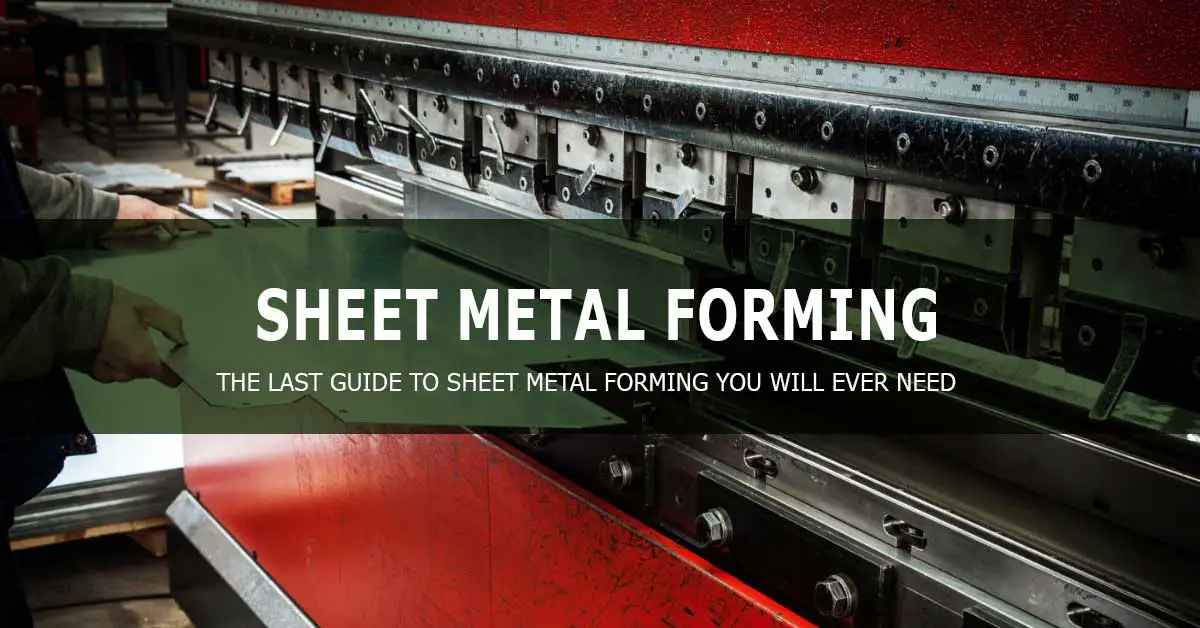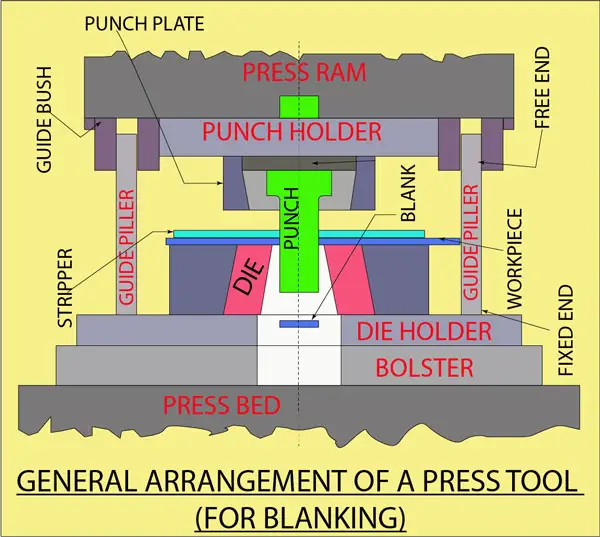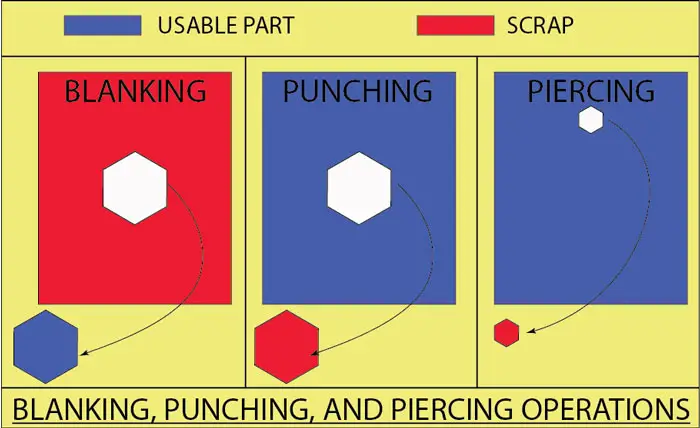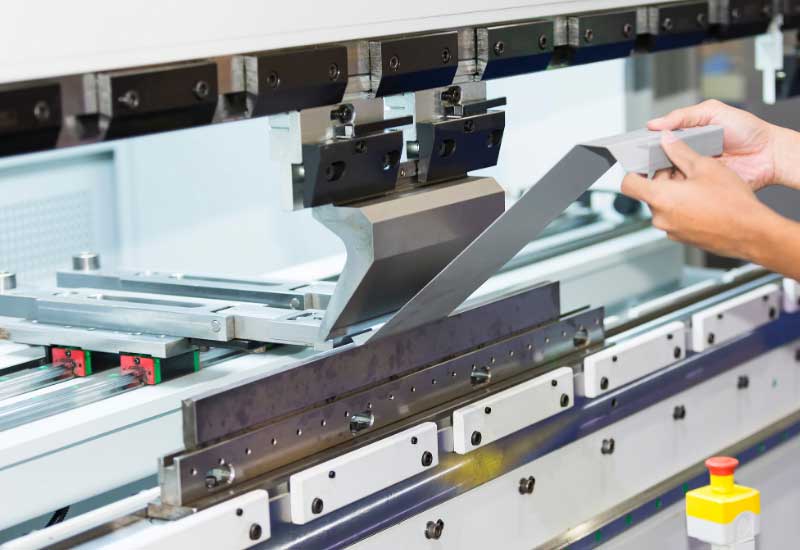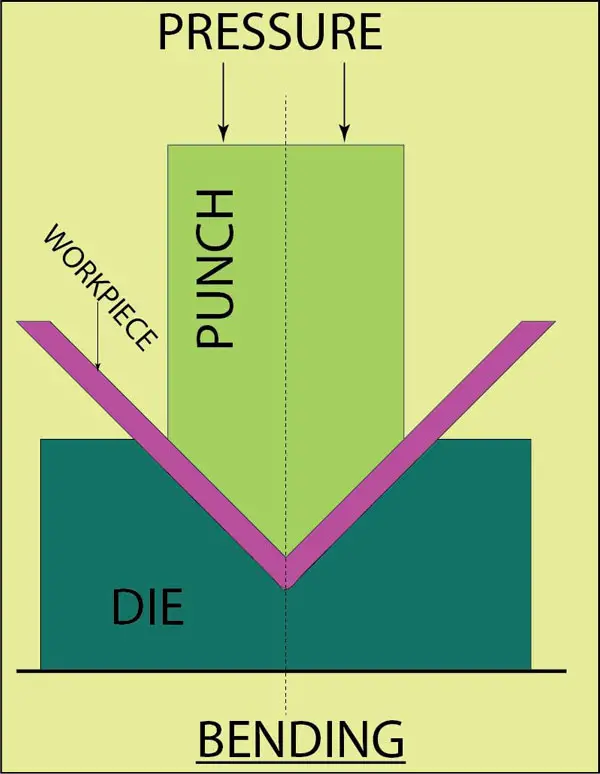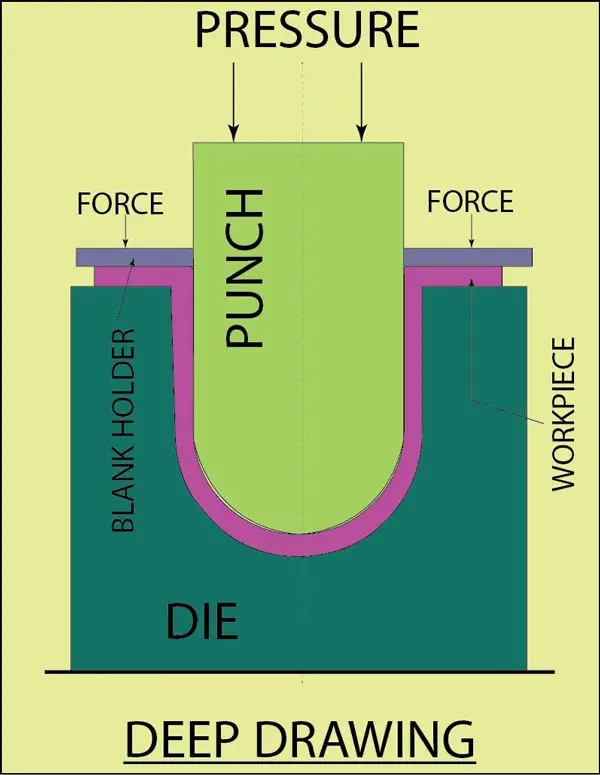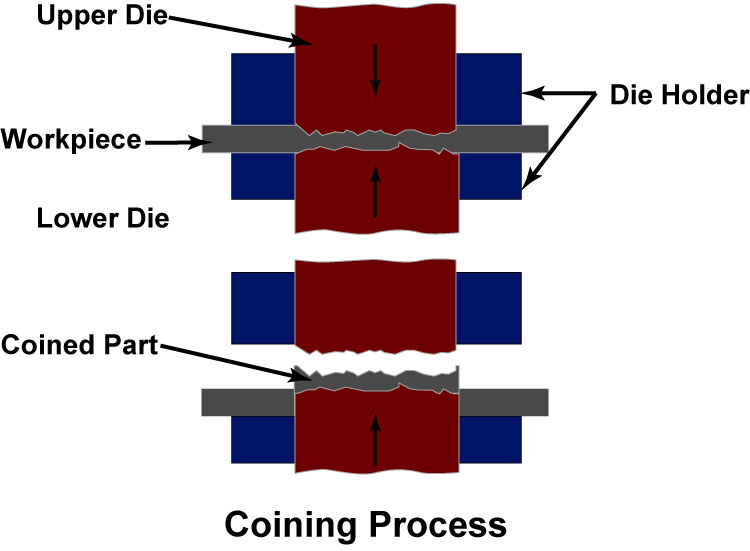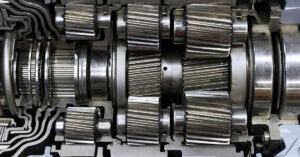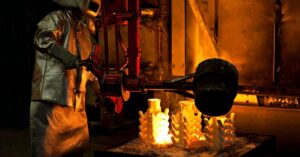Metal forming processes are broadly divided into Bulk metal forming and Sheet metal forming processes.
Shearing (piercing, blanking, punching, trimming, notching, nibbling, and perforating), bending, drawing, embossing, coining, etc., which mainly involves sheet metal, are called sheet metal operations.
In this article, we will explore all sheet metal forming processes one-by-one.
Sheet metal forming and sheet metal operations
You can see the products made by sheet metal forming, almost at every place, such as the body of your car, panels of your motorcycle, the filing cabinets or your desk in the office, beverage cans, etc. Utensils made from metal are one of the best examples of sheet metal operation, and sheet metal forming of utensils dates back to 5000 BC. During the earlier times, utensils were made by hammering silver, copper, etc., and the heat was used wherever necessary.
Parts produced by sheet metal operation are lightweight and different shapes are possible. Low carbon steel is a popular and most commonly used sheet metal for applications like domestic appliances, office and domestic furniture, cabinets, fabrication of industrial machinery, etc. Low carbon steel has the advantage of low cost, good strength, and formability.
Stainless steel is used for domestic appliances and industrial use due to its resistance to rusting, aesthetics, and good formability. Aluminum sheet metal parts find their application both in domestic appliances and industries like automobile and aerospace industries (for their lightweight). Titanium is also used in the aerospace industry.
Read: An Overview Of Metal Forming Process.
Read: The Last Guide To Bulk Metal Forming You Will Ever Need.
Let us go through different sheet metal operations shearing, bending, and forming.
1. Shearing Process
Shearing is basically a cutting operation; you can use a shearing machine to cut/shear a blank of required dimensions from a larger sheet. However, you will need circular blanks, sheet metal with one or more punched holes of specified shape at specified locations, etc., for the production work. Even though these are basically cutting/shearing operations, you will need dedicated press tools for doing it.
Die material – The tools and dies used for shearing are normally made of tool steels, and carbides are used for a high rate of production.
Lubrication – The use of a good lubricant is important for reducing tool and die wear as well as improving edge quality.
Advantages of shearing
- The shearing operation is fast and cost-effective.
- The scrap generated can be used for a different part or recycled.
- Suitable for large-scale production.
Disadvantages of shearing
- Dies and presses are costly.
- Not suitable for small quantity.
Application of shearing
- Home appliances, utensils, automobiles, aerospace, and other industries.
The shearing process is subcategorized into the following processes:
A. Die and punch
A press tool used on a press consists of (1) an upper part called a punch, held in a punch holder, (2) a lower part called die, held in a die holder, (3) stripper, and (4) guide pillar & bush. The upper part (punch) and the lower part (die) are held in a properly assembled position using guide pillars and pillar bushes. Depending on the size of the die, there can be 2 or 4 guide pillars.
Your die and punch arrangement is used for shearing operations such as blanking, punching, piercing, notching, nibbling, and trimming. The amount of clearance between the shearing punch and die influences the finish of the sheared workpiece. The sheared edges may not be smooth and perpendicular, and the edge will be shiny due to its rubbing with the walls of the die. The optimum clearance between the punch and die for shearing is 2 to 10% of the thickness of the sheet. Higher clearance makes the material pulled into the die, resulting in rough sheared edges.
The speed of the punch influences the quality of the sheared edge; the higher the punch speed the better is the edge quality.
B. Punching and blanking
You can explain punching or blanking as a sheet metal operation, where a part of the metal is sheared off a large sheet or metal strip.
When you do punching, a piece of metal is removed from the inside of the part, and when you do blanking, the metal around the part is removed.
C. Blanking process
The upper part (punch) is bolted to the ram of the press, and the lower part is bolted to the press table. The ram comes down for the working stroke, and the punch penetrates the metal strip. When the ram goes up (return stroke), the cut blank tends to stick to the punch; however, the blank is separated from the punch by the stripper.
After the blank is cut, the metal strip is fed forward for the shearing of the next blank, and there will be locating/stop pins in the front and back to locate the sheet for blanking properly. The opening of the die (bottom) is given an angular clearance to allow the free dropping of the blanks. The skeleton left (after the blanks are cut) is considered as scrap.
The clearance angle depends on the workpiece material and its thickness. For most of the cases, 2º clearance will be sufficient. In a blanking process, the die size =blank size, and in a punching process, punch size = blank size. There are formulae to determine the punch size for blanking and the die size for punching.
D. Piercing
In piercing, you are cutting a hole (of the desired shape) in the sheet metal, and the location of the hole can be anywhere on the sheet (including the edge). When you pierce a hole on the sheet metal, the material removed is considered as scrap.
F. Trimming
Parts produced by an impression die forging leave an extra amount of metal (flash) spread out along the periphery, and this flash is cut off using a trimming die. Trimming operation is similar to blanking, and dies used for trimming resemble a blanking die. However, the press used for trimming may have a relatively large table, considering the forging size.
G. Notching
In notching, you are removing a small portion of the sheet metal from a blank. Notching is different from piercing/punching since, in notching, the cutting line of the notched shape must touch at least one edge of the blank. The notch can be of any desired shape, and notching can be an operation for fitting/bending.
H. Nibbling
You use a nibbling machine for doing nibbling operations. Nibbling is a very versatile machine and has different tools for cutting circular blanks, punching holes, forming flanges, louvers, etc.
I. Perforating
Perforating is an operation where you are punching several uniformly spaced holes in sheet metal. The holes can be of different shapes or sizes. Normally, the holes cover the complete area of the sheet.
2. Bending Process
Bending is a very common sheet metal forming operation used not only to form a shape like seams, corrugations, and flanges but also to provide stiffness to the part.
As you bend sheet metal, its fibers nearer to the outside convex surface are forced to stretch (undergoes tension stress) while the fibers on the inner surface are forced to contract (undergoes compression stress). The plane that separates the two zones (tension and compression) is called the neutral axis.
When you apply load on the sheet metal, it will bend to the shape of the die; however, as soon as the load is taken off, the sheet metal tries to go back to its original state, and it partially succeeds (due to elastic recovery). This is called spring back. The spring back results in a larger radius (than the desired radius) and a smaller bend angle, and it can be either positive or negative. Spring back can occur in sheets, plates, rods, and pipes. You can compensate for the spring back by over-bending the part (quantum of over-bend should be based on its production history/calculated).
Bending can be done in a cold or hot state. Bending done at elevated temperatures may not have the issue of spring back. As you decrease the ratio of the bend radius to the sheet thickness (R/T ratio), the tensile stress on the outer fibers of the sheet will increase. Suppose you decrease the R/T ratio beyond a limit. In that case, cracks will appear on the outer surface of the sheet material, and this limit is called the minimum bend radius for that material. The minimum bend radius for metal is normally expressed in terms of its thickness, such as 2T, 3T, etc.
Advantages of bending
- Accurate and suitable for large-scale production.
- In many cases, the parts after bending can be used with nil or minimum secondary operations.
Limitations of bending
- The high initial investment, hence cannot be used for low batch production.
3. Drawing Process
The drawing process is a sheet metal operation to convert a flat blank of sheet metal into a hollow vessel, without wrinkles and cracks (and without trimming) and in cold or hot conditions. The process involves forcing the sheet metal blank into a die cavity with a punch.
The punch exerts sufficient force, and the metal is drawn over the edge of the die opening and into the die when forming a cup; however, the metal goes completely into the die. For doing the drawing operation, a setup of die and punch is used. Unlike in blanking, the die and punch used for forming have round corners to enable smooth metal flow during drawing.
Drawing process
- The sheet metal blank of appropriate size is placed on the die (there will be locating pins or locating face on the die for placing the blank).
- A lubricant is normally applied all over the blank, which helps reduce friction and, hence, the reduction of drawing load.
- The punch slowly comes down on the blank, the blank is drawn into the die, and it is formed into the shape of the cup as the punch reaches its bottom-most position.
- As the drawing progresses, the blank holder allows the metal to flow only radially.
- The die has a counterbore at its bottom end. When the punch reaches the counterbore portion of the die, the cup formed by the punch expands a little due to the spring back. When the punch goes upon its return stroke, the counterbore on the die pushes the cup down.
- When the height of the cup formed is less than half of its diameter, it is called shallow drawing, and when the height is greater than ½ diameter, there can be a risk of wrinkling at the edges.
There are formulae available in the handbooks for the calculation of blank diameter and the drawing force. These formulae consider the dimensions of the cup to be drawn, the strength of the metal, and some constants.
4. Embossing Process
Embossing is a sheet metal operation performed using matching male and female dies, and the depth of metal drawn is less. You can use embossing to stiffen metal panels or make decorative items like vehicle number plates, nameplates, jewelry, etc. You can emboss alphabets, numbers, logo designs, etc., on sheet metal parts.
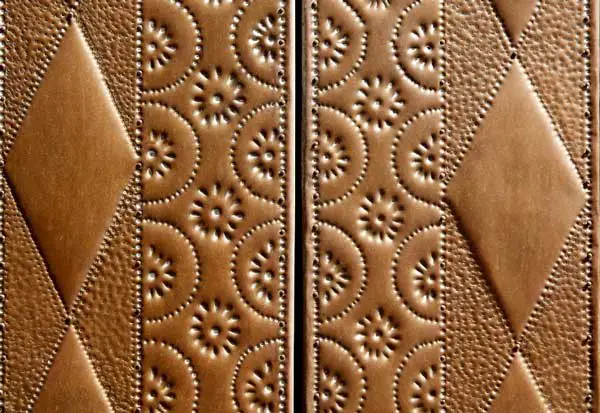
5. Coining Process
The coining process involves severe squeezing of the metal, and the flow of the metal happens only at the top layers of the metal (not throughout). Coining is principally a cold working process.
You will be using closed dies to carry out the coining process, and the main application is to produce the fine details needed for minting the coins and medals. The process of coining can be used for making jewelry also. Coining, being a cold working process, requires very high pressure. You may need more than one coining operation when the details to be coined are more.
What is the difference between coining and embossing?
Embossing creates the same design on both sides of the workpiece, one is raised, and the other is depressed, whereas the coining operation creates a different design on each side of the coin (workpiece). Also, the coining die is more complicated and intricate compared to an embossing die.
Advantages of coining
- The coining process is accurate, consistent, and produces finer details with a good surface finish.
- Plastic flow in cold conditions reduces the surface grain size, and work hardening improves the strength of the workpiece (coin).
- The machinery required is not very expensive.
- The coins are normally good to go immediately after the coining operation.
Applications of coining
- Production of coins and medals.
- Jewelry industry.
- Production of complex electronic parts.
Press and tools/dies used for sheet metal operations
Different processes used for the manufacturing of dies include casting, forging, conventional-machining, grinding, and nonconventional processes (electrical/electrochemical). Many parts of the press tool (mainly punch and die) are heat-treated to make them hard and resistant to wear. A fine finish is achieved by grinding and polishing.
Cast steels are used for larger parts. There are many unconventional machining processes, like EDM (electro-discharge machining), which can be used if necessary.
There can be a case of die failure, and the reasons for the failure can be faulty tool design, defective material, overloading, faults in heat treatment, misuse, etc. Because of this, proper care needs to be taken at the design stage, manufacturing stage, and user stage of the dies.
Types of dies
The die can be an inverted die, a compound die, or a progressive die.
In an inverted die, the die is fastened to the ram of the press, and the punch is fastened to the bed of the press.
A compound die is a combination of conventional and inverted die, and using this die; you can do both punching and blanking.
A progressive die, as the name suggests, does more than one operation progressively.
Types of presses
Let us briefly discuss the presses used for sheet metal forming.
The presses can be classified based on their source of power, construction and frame type, type of drive, and applications. The presses can be manually operated press, mechanical press, hydraulic press, and pneumatic press based on the source of power.
- The manually operated press can be foot-operated, screw operated, or gear operated. You can use this for small bending/ forming operations where the load required is less.
- The mechanical press utilizes a power-driven flywheel to convert the rotary motion to reciprocating strokes (through cranks, eccentrics, gears, etc.).
- The hydraulic press uses the power of pressurized hydraulic oil for pressing, and it is done by the coordination of pumps, valves, intensifiers, and accumulators in the hydraulic system.
- The pneumatic press utilizes the power stored in the compressed air for exerting the required force. Pneumatic presses are smaller when compared to mechanical and hydraulic presses.
The sheet metal forming presses can be single action presses, double-acting presses, and triple-acting presses.
The single-acting press has a fixed bed on which the die is clamped and a reciprocating ram that holds the punch. The single-acting press is a popular type of press used for blanking, coining, embossing, etc.
The double-acting press has a fixed bed and two slides moving in the same direction above it. This is better suitable for drawing operations (specifically for deep drawing) when compared to single-acting presses. The two slides are normally designated as the outer blank holder slide and the inner draw slide.
The blank holder slide’s shape is a hollow rectangle, and the inner slide which reciprocates within the blank holder has its shape as a solid rectangle. Also, the blank holder slide’s stroke is shorter, reaches the workpiece before the punch mounted on the inner slide touches the workpiece, and dwells at the end of the stroke. While the blank holder dwells (holding the blank), the inner slide has the complete press capacity for doing the drawing operation.
The triple acting press has three moving slides, the blank holder and the inner slide are exactly similar to a double-acting press, and the third (lower) slide moves upward through the fixed bed in the opposite direction of the other two slides. The triple acting press allows reverse drawing or forming operations, while the other two slides are dwelling. The cycle time for the triple-action press is longer than the double-action press.
The presses may have different frames and construction, such as arch-frame presses, gap-frame presses, straight-slide presses, and horn presses.
- Arch frame presses are not common and are not used for sheet metal. They are used for forging.
- Gap frame presses have a C-shaped frame and are the most commonly used press. They offer the most versatility since there is unobstructed access to the dies from all three sides, and many presses of this type have their back open for the ejection of scrap or parts.
- Straight side presses are stronger, and the strong side frame can take the heavy loads in a vertical direction. These presses are normally of high capacity.
- Horn press is similar to gap frame press; however, in horn press, the flywheel is slightly projected (overhanging) out words.
Conclusion
What is metal forming? You can define metal forming as a process that uses its ability to flow plastically under force to transform the metal to the required geometrical shape. Metal forming is achieved by the permanent deformation of the metal to a desired and useful shape. However, the amount of pressure applied should be sufficient for the metal to yield for permanent deformation. Any increase of pressure beyond a limit leads to cracks/material failure.
The metal forming can be done in three conditions cold, warm, and hot. Cold forming indicates the forming of metal at its room temperature, and warm and hot forming indicates forming of metal at its elevated temperature.
References:

